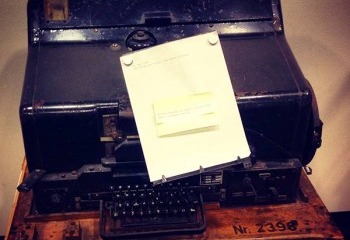
Insights
IV’s Favorite Inventions: Cipher Machines
July 14, 2016

July 14, 2016
If you ever visit Intellectual Ventures’ offices, you’ll notice that a few interesting inventions make their homes in our hallways. One of these looks like a typical typewriter — in fact, you would likely pass by it without a second glance, if you noticed it at all.
But beneath its unexceptional appearance lies a technology that is anything but ordinary. This is an example of a T-52 cipher machine.
No, we’re not talking about the villain from the Matrix movies. A cipher, more or less, is an algorithm used to encrypt a message. In order to fully appreciate the T-52, let’s take a journey through the evolution of this invention.
One of the earliest recorded ciphers is the Caesar shift cipher, which as legend has it, was used by Julius Caesar in his private messages. To illustrate this cipher’s process, let’s look at a simple message: HELLO WORLD. If the letters are shifted by one place in the alphabet, they read: IFMMP XPSME. This is a message encrypted with a Caesar shift of one place.
Fast forward to the 1460s, when Italian architect Leon Alberti came up with an idea. Why not alternate alphabets to encrypt a message? Instead of just using one alphabet, perhaps two would be better. Why not take it one step further and use several alphabets to encrypt a message? To decipher such a message, Alberti devised a disk that included two concentric copper rings, each with an alphabet printed on it. The two discs could be independently rotated so the alphabets would have relative positions to each other, with the outer ring featuring the plaintext alphabet and the inner ring representing the cipher alphabet — the alphabet you would use to write your secret message. As long as the recipient knew to shift the rings to the correct place, they would be able to decode the message.
Encryption machines continued to improve in the centuries that followed. By the World Wars, machines such as the Enigma — invented by Arthur Scherbius — were light weight, electrical, and played an important role in communications by governments and their militaries. They also spurred the creation of other inventions to aid in cracking their codes.
The cipher machine in our hallway, the T-52 Geheimschreiber, was developed by Siemens & Halske, but based largely off the Enigma concept. It was invented by August Jipp, Ehrhard Roßberg, and Eberhard Hettler in 1930. Used alongside Enigma machines, the T-52 assisted in not just static printed messages, but also in tele-printer (telex) messages. About 380 machines survived the war, including the one on display at IV’s headquarters.
Now that you know the history of cipher machines, imagine the types of messages that might have passed through their keys. While the cipher in our hallway might still look like a standard typewriter, the story behind the invention makes it one of IV’s favorites.
To learn more about inventions in history, read about one of the inventor community’s most famous code crackers: Hedy Lamarr.